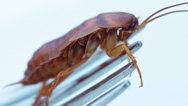Cook's Illustrated: Sauces
- Posted 10.25.12
- NOVA scienceNOW
How do you make a vinaigrette that tastes great but won't separate? The key is in the emulsifier. Discover why emulsifiers—like mustard, mayonnaise, and egg yolk—hold oil and vinegar together, and learn how to make a foolproof dressing.
Transcript
Cook's Illustrated: Sauces
Posted: October 25, 2012
Cook's Illustrated
The Science of Good Cooking
Concept 36: Emulsifiers Make Smooth Sauces
Dan Souza (Associate Editor, Cook's Illustrated): A vinaigrette seems simple because at its most basic, it's composed of two ingredients: oil and vinegar. But a dressing made with just oil and vinegar has a tendency to break, or separate, very easily. If you dress salad greens with a broken vinaigrette, it's harsh and bristling in one bite, dull and oily in the next. The best vinaigrettes are the ones that stay together—at least for as long as it takes for you to dress and eat the salad. For that we need to form an emulsion, which is basically a suspension of one of the liquids in the other.
Now, you can form an emulsion pretty easily by just whisking them together in a bowl, but that form of temporary emulsion is only going to last a couple of minutes—it's going to separate back out. The secret to a vinaigrette that stays together? Adding an emulsifier such as egg yolk, mayonnaise, or mustard can keep the emulsion intact longer. So, how does it work?
Well, each emulsifier contains an emulsifying agent. And each emulsifying agent, such as a lecithin molecule in egg yolk, has two ends. One is hydrophilic, meaning water-loving, while the other is hydrophobic, meaning it repels water, but that side is compatible with oil. So, what happens is the hydrophobic end dissolves in the oil, while the hydrophilic end dissolves in the water component, in this case vinegar, forming a shield around small droplets of oil. This is the reason that small droplets of oil can stay suspended in vinegar in, say, mayonnaise. The real question for today is, what emulsifier do we add to our salad dressing?
To find out we made three vinaigrettes, using three common emulsifiers: egg yolk, mayonnaise, and mustard. We added a 1/4 cup of vinegar to the bowl of three stand mixers fitted with whisk attachments. To one we added one tablespoon of Dijon mustard, to the second we added a tablespoon of mayonnaise, to the third we added an egg yolk. Now, with the mixers running on medium-high speed, we drizzled 3/4 of a cup oil over 30 seconds. As a control, we also made a vinaigrette with no emulsifier, just vinegar and oil.
Then, we then set up a time elapse camera and waited for them to break. Now as you can see, the control began separating immediately, and was almost completely separated by the first 15-minute interval. The vinaigrette made with the mustard started to break around 30 minutes, and the vinaigrette made with mayonnaise lasted about an hour and a half. The vinaigrette made with egg yolk was clearly the most stable, it was still emulsified almost three hours after being mixed.
And the taste? The vinaigrette made with the egg yolk had an eggy flavor that some tasters didn't like. The mayonnaise didn't add much flavor, but imparted a slight creaminess that most tasters preferred. The vinaigrette made with mustard tasted best. So, how do you make a foolproof vinaigrette? For one tablespoon of vinegar and three tablespoons oil we add a 1/2 teaspoon of mayonnaise for its great emulsifying power and a 1/2 teaspoon of mustard, which boosts stability but also provides great flavor. So with an emulsifier in the mix, your vinaigrettes will stay together longer, ensuring you have perfect salads every time.
Credits
Production Credits
- Video short produced, photographed, and edited by
- Nick Dakoulas
- Test Kitchen Experiment Editor
- Dan Souza
- Project Editor
- Molly Birnbaum
- Science Editor
- Guy Crosby, Ph.D.
- Editorial Director
- Jack Bishop
- Original Footage and Illustrations
- © America's Test Kitchen 2012
Image
- (sauces)
- © America's Test Kitchen 2012
Related Links
-

Can I Eat That?
Learn about the neuroscience of taste, why we cook our food, what makes a Thanksgiving turkey savory, and more.
-

Cook's Illustrated: Sugar
Because of its chemistry, sugar does a whole lot more than add sweetness.
-

Food Science: Expert Q&A
Michael Brenner, who teaches a class on the science of cooking, talks about egg whites, ethylene, protein, and more.



